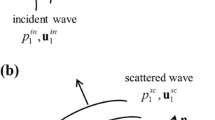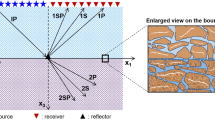Abstract
We studied finite-element-method-based two-dimensional frequency-domain acoustic FWI under rugged topography conditions. The exponential attenuation boundary condition suitable for rugged topography is proposed to solve the cutoff boundary problem as well as to consider the requirement of using the same subdivision grid in joint multifrequency inversion. The proposed method introduces the attenuation factor, and by adjusting it, acoustic waves are sufficiently attenuated in the attenuation layer to minimize the cutoff boundary effect. Based on the law of exponential attenuation, expressions for computing the attenuation factor and the thickness of attenuation layers are derived for different frequencies. In multifrequency-domain FWI, the conjugate gradient method is used to solve equations in the Gauss–Newton algorithm and thus minimize the computation cost in calculating the Hessian matrix. In addition, the effect of initial model selection and frequency combination on FWI is analyzed. Examples using numerical simulations and FWI calculations are used to verify the efficiency of the proposed method.
Similar content being viewed by others
References
Brossier, R., Operto, S., and Virieus, J., 2009, Seismic imaging of complex on shore structures by 2D elastic frequency-domain full-waveform inversion: Geophysics, 74(6), WCC105–WCC118.
Bérenger, J. P., 1994, A perfectly matched layer for absorption of electromagnetic waves: J. Comput. Phys., 114(2), 185–200.
Cao, S., and Greenhalgh, S., 1998, Attenuating boundary conditions for numerical modeling of acoustic wave propagation: Geophysics, 63(1), 231–243.
Cerjan, C., Kosloff, D., Kosloff, R., and Reshef, M., 1985, A nonreflecting boundary condition for discrete acoustic and elastic wave equations. Geophysics, 50(4), 705–708.
Chew, W. C., and Weedon, W. H., 1994, A 3D perfectly matched medium from modified maxwell’s equations with stretched coordinates: Microw. Opt. Tech. Lett., 7(13), 599–604.
Du, Q. Z., Li, B., and Hou, B., 2009, Numerical modeling of seismic wavefields in transversely isotropic media with a compact staggered-grid finite difference scheme: Applied Geopysics, 6(1), 42–49.
Du, Q. Z., Sun, R. Y., Qin, T., Zhu, Y. T., and Bi, L. F., 2010, A study of perfectly matched layers for joint multicomponent reverse-time migration: Applied Geophysics, 7(2), 166–173.
Dong, L. G., Chi, B. X., Tao, J. X., and Liu, Y. Z., 2013, Objective function behavior in acoustic full-waveform inversion: Chinese J. Geophys. (in Chinese), 56(10), 3445–3460.
Fichtner, A., and Trampert, J., 2011, Resolution analysis in full waveform inversion: Geophysical Journal International, 187(3), 1604–1624.
Gauthier, O., Virieux, J., and Tarantola, A., 1986, Twodimensional nonlinear inversion of seismic waveforms: numerical results: Geophysics, 51(7), 1387–1403.
Hicks, G. J., and Pratt, R. G., 2001, Reflection waveform Inversion Using Local Decent Methods:Estimating Attenuation and Velocity Over a Gas-Sand Deposit: Geophysics, 66(2), 598–612.
Hu, G. H., Jia, C. M, Xia, H. R., He, J. B., Song, L., and Shen, Z. Q., 2013, Implementation and validation of 3D acoustic full waveform inversion: Geophysical Prospecting for Petroleum, 52(4), 417–425.
Komatitsch, D., and Martin, R., 2007, An unsplit convolutional perfectly matched layer improved at grazing incidence for the seismic wave equation: Geophysics, 72(5), SM155–SM167.
Lailly, P., 1983, The seismic inverse problem as a sequence of before stack migrations//Conference on inverse scattering: theory and applications: Society of Industrial and Applied Mathematics, Proceedings, 206–220.
Long, G. H., Li, X. F., Zhang, M. G., and Zhu, T., 2009, Visco-acoustic transmission waveform inversion of velocity structure in Space-frequency domain: Acta Seismologica Sinica, 31(1), 32–41.
Liu, G. F., Liu, H., Meng, X. H., and Yan, H. F., 2012, Frequency-related factors analysis in frequency domain waveform inversion: Chinese J. Geophys. (in Chinese), 55(4), 1345–1353.
Malinowski, M., and Operto, S., 2008, Quantitative imaging of the Permo-Mesozoic complex and its basement by frequency domain waveform tomography of wide-aperture seismic data from the Polish Basin: Geophysical Prospecting, 56(6), 805–825.
Marfurt, K. J., 1984, Accuracy of finite-difference and finite-element modeling of the scalar and elastic wave equations: Geophysics, 49(5), 533–549.
Operto, S., Ravaut, C., Improta, L., Virieux, J., Herrero, A., and Dell'Aversana, P., 2004, Quantitative imaging of complex structures from dense wide-aperture seismic data by multiscale traveltime and waveform inversions: a case study: Geophysical Prospecting, 52(6), 625–651.
Plessix, R., and Perkins, C., 2010, Full waveform inversion of a deep water ocean bottom seismometer dataset: First Break, 28(1), 71–78.
Pratt, R. G., and Worthington, M. H., 1990, Inverse theory applied to multi-source cross-hole tomography. Part1: Acoustic wave equation method: Geophysical Prospecting, 38(3), 287–310.
Pratt, R. G., 1990, Inverse theory applied to multi-source cross-hole tomography. Part II: elastic wave-equation method, Geophysical Prospecting, 38(3), 311–330.
Pratt, R., Shin, C., and Hicks, G., 1998, Gauss-Newton and full newton methods in frequency-space seismic waveform inversion: Geophysical Journal International, 133(2), 341–362.
Pratt, R., and Sams, M., 1996, Reconciliation of crosshole seismic welocityies with well information in a layered sedimentary environment: Geophysics, 61(2), 549–560.
Pratt, R., 1999, Seismic waveform inversion in the frequency domain, part I: theory and verification in a physical scale model: Geophysics, 64(3), 888–901.
Qin, Z., Lu,. M. H., Zheng, X. D., Yao, T., Zhang, C., and Song, J. Y., 2009, The implementation of an improved NPML absorbing boundary condition in elastic wave modeling: Applied Geophysics, 6(2), 113–121.
Sirgue, L., Barkved, O., Dellinger, J., Albertin, U., and Kommedal, J. H., 2010, Full waveform inversion: the next leap forward in imaging at Valhall: First Break, 28(4), 65–70.
Shin, C., and Cha, Y. H., 2008, Waveform inversion in the Laplace domain: Geophysical Journal International, 173(3), 922–931.
Shin, C., and Cha, Y. H., 2009, Waveform inversion in the Laplace-Fourier domain: Geophysical Journal International, 177(3), 1067–1079.
Song, J. Y., Zheng, X. D., Qin, Z., and Su, B. Y., 2011, Multi-scale seismic full waveform inversion in the frequency-domain with a multi-grid method: Applied Geophysics, 8(4), 303–310.
Song, R. L., Ma, J., and Wang K. S., 2005, The application of the nonsplitting perfectly matched layer in numerical modeling of wave propagation in poroelastic media: Applied Geophysics, 2(4), 216–222.
Song, Z. M., Williamson, P. R., and Pratt, R. G., 1995, Frequency-domain acoustic-wave modeling and inversion of crosshole data: Part II-inversion method, synthetic experiments and real-data results: Geophysics, 60(3), 796–809.
Tarantola, A., 1984, Inversion of seismic reflection data in the acoustic approximation: Geophysics, 49(8), 1259–1266.
Tarantola, A., 1986, A strategy for nonlinear elastic inversion of seismic reflection data: Geophysics, 51(10), 1893–1903.
Wang, W., Han, B., and Tang, J. P., 2013, Regularization method with sparsity constraints for seismic waveform inversion: Chinese J. Geophys. (in Chinese), 56(1), 289–297.
Wu, X. P., and Xu, G. M., 1999, Derivation and analysis of partial derivative matrix in resistivity 3-D inversion: Oil Geophysical Prospecting, 34(4), 363–372.
Xu, S. Z., 1994, The Finite-Element Method in Geophysics: Beijing, Science Press, 261–285.
Xu, K., and Wang, M. Y., 2001, Finite Element Inversion of the Coefficients of Acoustic Equation in Frequency Domain: Chinese J. Geophys. (in Chinese), 44(6), 852–864.
Yang, Q. Y., Hu, G. H., and Wang, L. X., 2014, Research status and development trend of full waveform inversion: Geophysical prospecting for petroleum, 53(1), 77–83.
Yuan, S. Y., Wang, S. X., Sun, W. J., Miao, L. N., and Li, Z. H., 2014, Perfectly matched layer on curvilinear grid for the second-order seismic acoustic wave equation: Exploration Geophysics, 45(2), 94–104.
Zhao, J. G., Shi, R. Q., Chen, J. Y., Pan, J. G., and Wang, H. B., 2014, An matched Z-transform perfectly matched layer absorbing boundary in the numerical modeling of viscoacoustic wave equations: Chinese J. Geophys. (in Chinese), 57(4), 1284–1291.
Zhao, J. G., and Shi, R. Q., 2013, Perfectly matched layerabsorbing boundary condition for finite-element timedomain modeling of elastic wave equations: Applied Geophysics, 10(3), 323–336.
Author information
Authors and Affiliations
Corresponding author
Additional information
Zhang Qian-Jiang received his M.S. (2011) in Earth Exploration and Information Technology from China University of Petroleum (Beijing). He is presently a Ph.D. candidate in Geological Resources and Geological Engineering at Central South University. His main interests are forward modeling and inversion of seismic and electromagnetic data.
Rights and permissions
About this article
Cite this article
Zhang, QJ., Dai, SK., Chen, LW. et al. Two-dimensional frequency-domain acoustic full-waveform inversion with rugged topography. Appl. Geophys. 12, 378–388 (2015). https://doi.org/10.1007/s11770-015-0510-4
Received:
Accepted:
Published:
Issue Date:
DOI: https://doi.org/10.1007/s11770-015-0510-4




